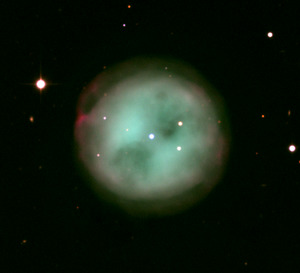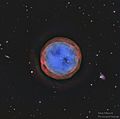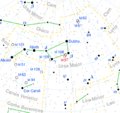Owl Nebula facts for kids
| Emission nebula | |
|---|---|
| Planetary nebula | |

Owl Nebula Messier 97
|
|
| Observation data: J2000.0 epoch | |
| Right ascension | 11h 14m 47.734s |
| Declination | +55° 01′ 08.50″ |
| Distance | 2,030 ly (621 pc) 2,800 ly (870 pc) ly |
| Apparent magnitude (V) | 9.9 |
| Apparent dimensions (V) | 3′.4 × 3′.3 |
| Constellation | Ursa Major |
| Physical characteristics | |
| Radius | 0.91 ly (0.28 pc) ly |
| Notable features | Owl-like "eyes" visible through larger telescopes |
| Designations | M97, NGC 3587, PN G148.4+57.0 |
The Owl Nebula (also called Messier 97, M97, or NGC 3587) is a beautiful cloud of gas and dust in space. It's about 2,030 light years away from us. You can find it in the northern part of the sky, in the constellation called Ursa Major, which is also known as the Great Bear.
Scientists think the Owl Nebula is about 8,000 years old. It looks mostly round, with some faint shapes inside. This nebula formed when a star in its center blew off its outer layers of gas. This happened as the star got older and bigger, reaching a stage called the asymptotic giant branch.
The nebula has three layers, like shells, one inside the other. The outer shell is a bit bigger than the inner one. The reason it looks a bit like an owl is because its inner layer isn't perfectly round. Instead, it's shaped more like a barrel, tilted at an angle.
The Owl Nebula holds about 0.13 times the mass of our Sun in gas. This gas includes elements like hydrogen, helium, nitrogen, oxygen, and sulfur. It's very spread out, with less than 100 tiny particles in each cubic centimeter. The nebula is still growing, expanding outwards at speeds between 27 and 39 km/s.
The star at the very center of the Owl Nebula is quite faint. It's now shrinking to become a white dwarf, which is a very dense, small star. This central star has about 55-60% of the Sun's mass. It shines 41 to 148 times brighter than our Sun and is super hot, with a temperature of 123,000 degrees Kelvin.
Contents
Discovering the Owl Nebula
The Owl Nebula was first found by a French astronomer named Pierre Méchain. He spotted it on February 16, 1781. Pierre Méchain worked with another famous astronomer, Charles Messier.
Just a few weeks after Méchain's discovery, Messier himself observed the nebula. He then added it to his special list of celestial objects, called the Messier Catalog. This is why it's also known as Messier 97.
Messier wrote about the nebula on March 24, 1781. He noted that it was hard to see, especially with bright lights around. He described it as faint, without any stars visible inside it. Méchain also saw two other nebulae nearby, which later became Messier 108 and Messier 109.
In 1844, an admiral named William Henry Smyth looked at the object. He was the one who officially called it a planetary nebula.
How the Owl Nebula Got Its Name
The name "Owl Nebula" came from William Parsons, 3rd Earl of Rosse. He was an astronomer who observed the nebula from Ireland in 1848. When he drew what he saw through his telescope, it looked a lot like an owl's head.
In his notes, Lord Rosse described seeing two stars in the middle of the nebula. He also mentioned dark shadows around them and a spiral shape. He said it looked like stars were sparkling inside it. From that moment on, the object has been known as the Owl Nebula.
Later, in the late 1900s, scientists made more discoveries. They found a huge red glow of gas, like a halo, around the nebula's inner parts. They also mapped out its detailed structure.
Observing the Owl Nebula
You can't see the Owl Nebula with just your eyes. But if the sky is very clear and dark, you might be able to spot a faint image of it. You would need a small telescope or strong binoculars (like 20x80).
To see the nebula's famous owl-like "eyes," you'll need a bigger telescope. One with a 10-inch wide lens or mirror (called an aperture) or larger is best.
To find the Owl Nebula in the night sky, first look for the Big Dipper. It's a well-known group of stars. Find the southwest corner of the Big Dipper's "bowl." This corner is marked by the star Beta Ursae Majoris.
From Beta Ursae Majoris, look about 2.5 degrees to the southeast. This direction is towards the star Gamma Ursae Majoris. Gamma Ursae Majoris is in the other bottom corner of the Big Dipper's bowl. The Owl Nebula (M97) is located in that area. M97, along with another star called Alpha Ursae Majoris, can even help you find Polaris, the North Star!
Gallery
See also
 In Spanish: Nebulosa del Búho para niños
In Spanish: Nebulosa del Búho para niños
- Messier object
- List of Messier objects
- New General Catalogue
- List of planetary nebulae




